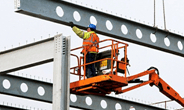Steel Markets

AGC: Construction Costs Rise in June Despite Declines in Metals, Wood
Written by David Schollaert
July 17, 2022
The prices contractors pay for construction materials and services – chiefly for new nonresidential construction – rose by 1.1% month-on-month (MoM) in June, outpacing the rise in contractors’ bid prices, the Associated General Contractors of America (AGC) reported in its latest analysis of government data.
AGC warned that rising materials prices were adversely impacting a growing number of construction projects that have suddenly become more expensive.
“Some materials prices have fallen recently but others appear headed for further increases,” AGC chief economist Ken Simonson said. “Since these prices were collected, producers of gypsum, concrete, and other products have announced or implemented new increases. In addition, the supply chain remains fragile, and persistent difficulties filling job openings mean construction costs are likely to remain elevated despite declines in some prices.”
Citing the Bureau of Labor Statistics, AGC said that the producer price index (PPI) for inputs to nonresidential construction – the prices charged by goods producers and service providers such as distributors and transportation firms – have increased by nearly 17% since June 2021.
Meanwhile, the index for new nonresidential building construction – a measure of what contractors calculate they would charge to erect five types of nonresidential buildings – climbed by 0.5% MoM and 19.8% year-on-year (YoY).
A diverse mix of inputs accounted for the increase in the cost index even as prices for several metals and wood products declined, said Simonson.
The price index for diesel fuel soared 14.1% in June and more than doubled YoY, rising 111.1% since June 2021. The index for asphalt and tar roofing and siding products rose 3.2% MoM in June and 22.2% YoY. The index for plastic construction products rose 1.5% MoM and 27.0% YoY. Insulation materials climbed 1.2% in price last month and 16.0% YoY. The index for concrete products rose 1.7% in June and 13.5% over 12 months. The index for paving mixtures and blocks increased 2.9% MoM and 17.9% YoY.
These increases more than offset declines in indexes for metals and lumber. There were one-month decreases in June in the index for copper and brass mill shapes (-1.6%), steel mill products (-1.8%), aluminum mill shapes (-5.2%), and lumber and plywood, (-14.7%).
AGC said public officials had a vested interest in taking steps to address rising materials prices, noting those price increases were making it more expensive to build all manner of public infrastructure projects. The association urged the Biden administration to remove remaining tariffs on a range of construction materials and for public officials at all levels to take steps to help unclog backed-up supply chains.
“The more materials prices increase, the harder it will be for public officials to build new schools, roads, and other infrastructure,” AGC CEO Stephen Sandherr said. “Taking steps to address rising materials prices will help construction employers and taxpayers alike.”
Editor’s note: AGC chief economist Ken Simonson will be the featured speaker on the next SMU Community Chat webinar on Wednesday, July 27, at 11 am ET. You can register here.
By David Schollaert, David@SteelMarketUpdate.com

David Schollaert
Read more from David SchollaertLatest in Steel Markets

CRU: Sheet import demand softens as domestic price gains have slowed
US domestic sheet price gains have begun to slow as previously pulled-forward demand has led to a decline in orders.

CMC looks beyond Arizona micro-mill woes to long-term viability of construction mart
Despite the economic and geopolitical upheaval of the last five years, CMC President and CEO Peter Matt points out that the construction market has been an essential element of the way forward.

US importers face stricter rules under revamped S232 tariffs
“CBP expects full compliance from the trade community for accurate reporting and payment of the additional duties. CBP will take enforcement action on non-compliance," the agency said in a March 7 bulletin.

Steel exports rebound in January
US steel exports recovered to a five-month high in January after having fallen to a two-year low in December. This growth follows four consecutive months of declining exports.

Construction spending drops marginally in January
Construction spending edged down slightly in January, slipping for the first time in four months. The US Census Bureau estimated spending at a seasonally adjusted annual rate of $2,196 billion in January, down 0.2% from December’s downward revised rate. The January figure is 3.3% higher than a year ago. January’s result, despite the slight erosion, […]
